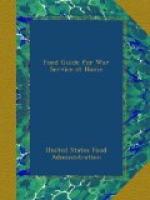Corn, the most abundant substitute. Indian corn is native to the United States. Since it carried the Pilgrims through their year of famine, it has always been considered our national grain. Other countries have adopted it to some extent, but more than three quarters of the world’s corn is grown here. In 1917 our corn crop was 3,000,000,000 bushels, four times as large as our wheat crop. Most of the crop has always been used as a feed-grain, with only a small percentage for human food. The South has always used much more corn than the North, actually eating more corn than wheat.
The foods from corn and the ways of using them are more numerous than is often appreciated. Corn meal and corn flour are the most important. We are making almost as much corn meal as wheat flour. The yellow and white corn meals, milled from different kinds of corn, are practically the same in composition, though slightly different in flavor. The method of milling corn meal makes more difference in the composition than the kind of corn used. The old “water-ground” meal was simply crushed between millstones and only the coarsest particles of bran bolted out. This ranks with Graham as a product of 100 per cent extraction and like Graham, it may not keep well, because the germ is left in. The new process, more like modern flour-milling, removes some of the bran and germ. The product is a granulated corn meal which keeps better than the other, and has practically the same composition, though to some people a less desirable flavor.
If corn meal is further ground and bolted, we have corn flour. Some of this has been put on the market lately and is proving a good substitute for wheat flour; but the amount available is only a small fraction of the amount of corn meal. Other important corn products are hominy of different kinds, hulled corn, and popcorn. The latter, usually eaten as an “extra,” is really a valuable part of the diet.
Corn is the same satisfactory food whether it is eaten as mush in New England, polenta in Italy, or tamales in Mexico. Many of the people of Mexico and Central America live on corn and beans to a surprising extent. In portions of Italy the rural population have adopted the grain as their main food. Our corn-meal mush is their polenta, which is served sometimes with cheese, sometimes with tomato sauce or meat gravy.
Oats. An Englishman once taunted a Scotchman with the fact that while England used oats only for her horses, Scotland fed it to her men. “Ah!” said Sandy; “but where will you find such horses as you raise in England and such men as in Scotland!”




